Ch. 10 - Muscle Gross Anatomy
1/42
There's no tags or description
Looks like no tags are added yet.
Name | Mastery | Learn | Test | Matching | Spaced |
|---|
No study sessions yet.
43 Terms
Functions of Muscles
Movement
Stability
Control of openings
Heat production
Glycemic control
How muscles help with movement:
they allow us to move from place to place, they move body parts, and they move body contents in breathing, circulation, and digestion
In communication: speech, writing, facial expressions and other nonverbal communications
How muscles help with stability:
Maintains our posture by preventing unwanted movements
work as “antigravity” muscles by preventing us from falling over
Stabilize our joints by maintaining tension
How muscles help control openings and passageways:
there are muscles called sphincters shaped in a ring that control the movement of food, blood, and other materials within body
these muscles open/close openings
How muscles help with heat production:
the friction of our skeletal muscles produces as much as 85% of our body heat
How muscles help with glycemic control:
Muscles absorb and store glucose which helps regulate blood sugar concentration within a normal range
can store but cannot release into blood stream like liver tissue can
Approximately how much body weight do our muscles constitute?
half of our body weight
What is the major purpose of muscles?
to convert the chemical energy in ATP into the mechanical energy of motion
Myology
the study of the muscular system
Epimysium
connective tissue surrounding entire muscle
is continuous to the fascia
holds fascicles together
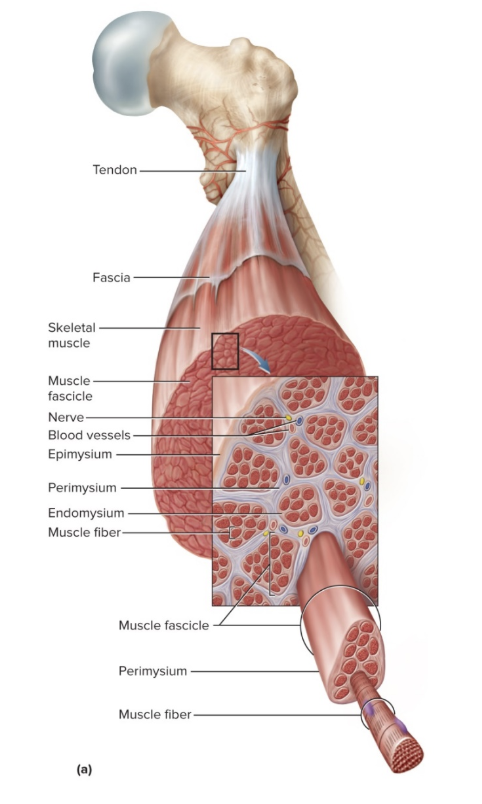
Fascia
thick layer of collagen that leads into the tendon
separates neighboring muscles or muscle groups from each other and the subcutaneous tissue
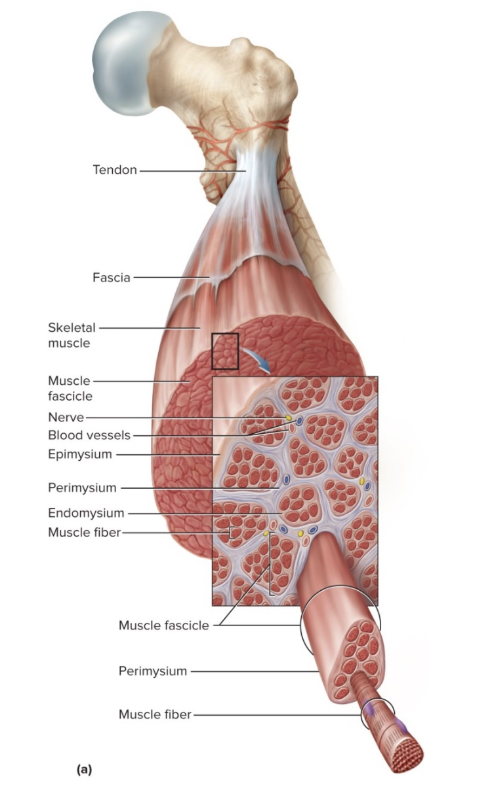
Perimysium
Thicker layer of connective tissue that wraps fascicles and holds them together
Carries nerves, blood vessels, and stretch receptors
Fascicles: bundles of muscle fibers wrapped together
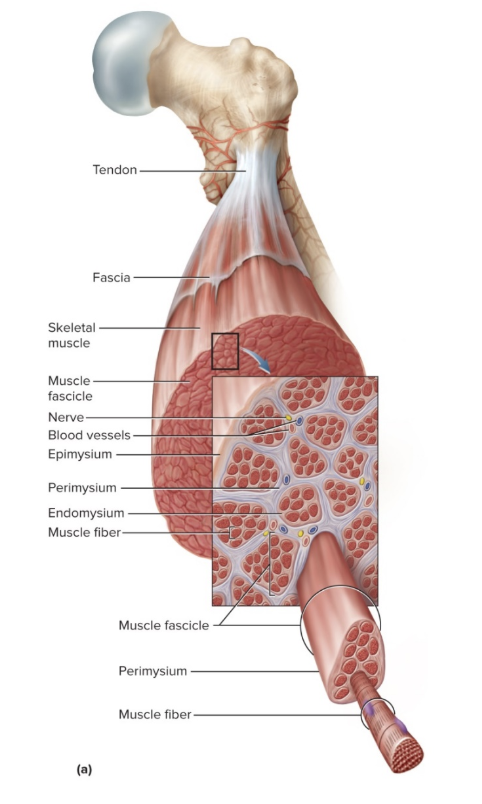
Endomysium
Thin sleeve of loose connective tissue around each muscle fiber/cell
Electrically insulates muscle cells
Allows room for capillaries and nerve fibers
Provides chemical environment for muscle fiber
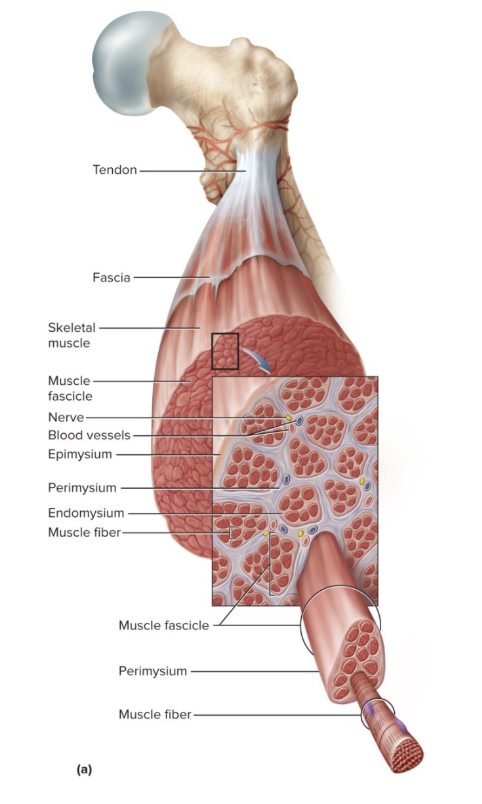
Strength of a muscle and the direction of its pull are determined partly by….
the orientation of its fascicles
Fusiform Muscles
thick in the middle and tapered at each end
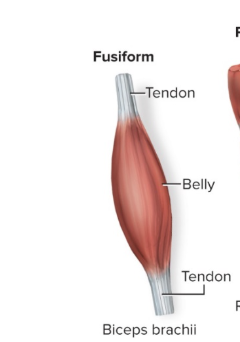
Parallel Muscles
uniform width and parallel fascicles
most parallel muscles have the word rectus in the name
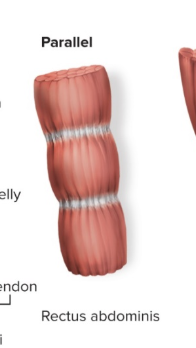
Triangular (Convergent) Muscles
broad at one end and narrow at the other

Pennate Muscles
feather shaped
pennate muscles are the strongest shape
can pack the most muscle together
includes:
Unipennate
Bipennate
Multipennate
Unipennate
fasciles approach tendon from one side

Bipennate
fascicles approach tendon from both sides
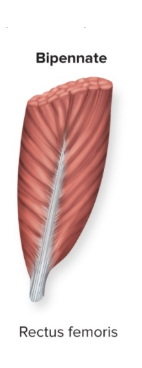
Multipennate
bunches of feathers converge to single point
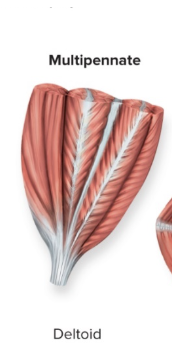
Circular Muscles (Sphincters)
form rings around body openings
weakest muscles in the body
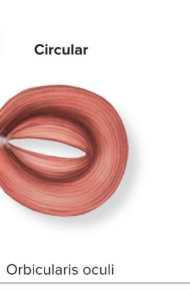
Muscle Compartment
A group of functionally related muscles enclosed by fascia
Also contains nerves and blood vessels that supply the muscle group
these compartments are good bc they slow/stop the spread of pathogens from one compartment to another
Intermuscular Septa
very thick fascia that separate one compartment from another
Indirect Attachment to Bone
muscles attaching to bone indirectly using tendons
Tendons
connects muscles to bones
Collagen fibers of the endomysium, perimysium, and epimysium continue into the tendon all the way into the periosteum and matrix of the bone
Aponeurosis
tendon is a broad, flat sheet (palmar aponeurosis)
ex) abdomen, top of the head (frontalis to occipitalis)
Retinaculum
connective tissue band that tendons from separate muscles pass under
keeps tendons from getting tangled
Direct (fleshy) Attachment to Bone
no visible tendon
Little separation between muscle and bone
Muscle seems to emerge directly from the bone
Some muscles attach on the fascia or tendon of another muscle or on collagen fibers of the dermis instead of bone
Origin
the end of the muscle that is closer to the heart
Insertion
the end of the muscle farther away from the heart
Intrinsic Muscle
muscle that is entirely contained within a region, such as the hand
Extrinsic Muscle
acts on a designated region, but has one attachment elsewhere
ex) extrinsic muscles in the forearm help move the wrist
Action
an effect produced by a muscle to produce or prevent movement
Four categories of muscle action:
prime mover
synergist
antagonist
fixator
Prime Mover (agonist)
Muscle that produces most of the force during a particular joint action
Synergist
muscle that aids the prime mover
can contribute additional force, modify the direction of movement, or stabilize a nearby joint
Antagonist
opposes the prime mover
Prevents excessive movement
Sometimes relaxes to give the prime mover control over an action
Antagonistic pairs—muscles that act on opposite sides of a joint
ex) elbow flexion: biceps brachii is the prime mover (agonist) and the triceps brachii is the antagonist
Fixator
muscle that prevents movement of bone
joint stabilization
Innervation
Innervation of a muscle refers to the identity of the nerve that stimulates it
Knowing innervation enables the diagnosis of nerve, spinal cord, and brainstem injuries from muscle tests
Spinal Nerves
arise from the spinal cord
emerge through intervertebral foramina
Immediately branch into posterior and anterior rami (branches of spinal nerves)
Innervates muscles below the neck
includes plexus
Plexus
web-like network of spinal nerves next to the vertebral column
Cranial Nerves
arise from the base of the brain
Emerge through skull foramina
Innervate the muscles of the head and neck
Numbered CN I to CN XII
Blood Supply
the muscular system receives 1/4 of the blood pumped by the heart per minute at rest
During heavy exercise, total cardiac output rises and the muscular system’s gets more than ¾ of the blood from the heart per minute
Capillaries branch through the endomysium to reach every muscle fiber